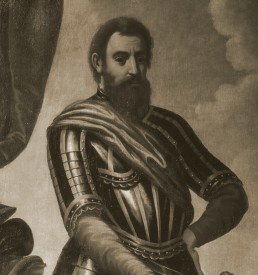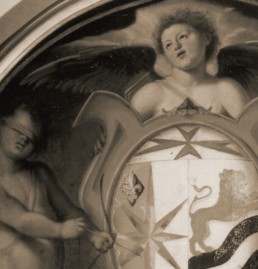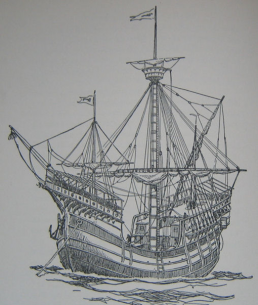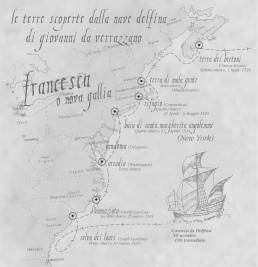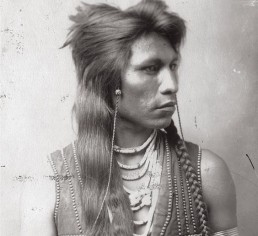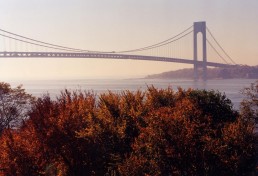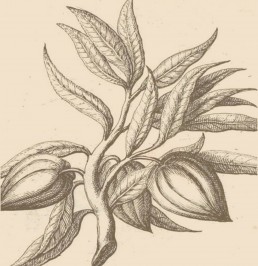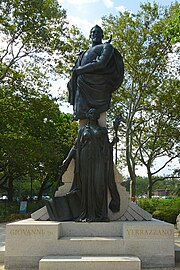Giovanni da Verrazzano was a Florentine explorer who was first to land on the Atlantic coast of North America. Although not much is known about his personal life, he had an interesting career which began as a pirate and ended in an unfortunate manner. Know more about him through these 10 facts.
#1 THERE IS CONFUSION REGARDING HIS BIRTHPLACE
There are a few theories about the birthplace of Verrazzano, the most prominent one being that he was born in Val di Greve near Florence, Italy, in 1485. This theory is supported by the facts that he himself, as well as his contemporaries, considered that he was Florentine.
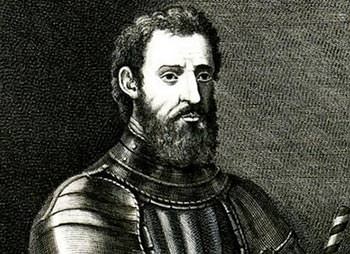
#2 HE SPENT HIS EARLY YEARS AS A PIRATE
In 1506, Verrazzano moved to the port of Dieppe in France. He spent many years as a pirate for France, preying on Spanish and Portuguese sea vessels. It is said that he was responsible for stealing gold worth $2 million from Spanish vessels.
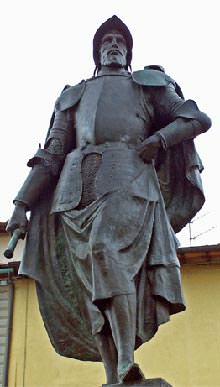
#3 VERRAZZANO SERVED KING FRANCIS I OF FRANCE
Giovanni da Verrazzano met King Francis I of France between 1522 and 1523. In early sixteenth century, Spanish and Portuguese explorers were exploring the west and Francis I was concerned that France would fall behind. Verrazzano convinced the King that he was the right man to lead the voyages.
#4 HE WANTED TO FIND THE SEA ROUTE TO THE PACIFIC OCEAN
The aim of Verrazzano’s 1524 voyage was to find a sea route to the Pacific Ocean and Asia. His ship La Dauphine, however, reached the Pamlico Sound lagoon of modern North Carolina near Cape Fear.
#5 HE DISCOVERED VARIOUS PLACES ALONG THE COAST OF NORTH AMERICA
Verrazzano began exploring the Atlantic coast of North America towards north. While doing so he discovered New York Harbor, Block Island and Narragansett Bay. However as he usually anchored far off-shore, he missed discovering the Chesapeake and Delaware Bays.

#6 HIS ONE ERROR SPLIT NORTH AMERICA IN TWO PARTS IN MAPS
While exploring North Carolina’s other side, Verrazzano believed that he saw the Pacific Ocean. He wrote so in a letter to Francis I. However what he saw was actually a part of the Atlantic Ocean. This fault by Verrazzano caused errors in maps for a century. They depicted North America as being split into two parts, connected by a narrow strip of land.
#7 VERRAZZANO WAS EATEN BY CANNIBALS
In March 1528, Verrazzano left France on his final voyage. His goal was to reach India. The expedition, which included his brother Girolamo, drifted into the Caribbean Sea. They found a vegetated island south of Jamaica and Verrazzano and his crew decided to explore it. Here they were caught by cannibalistic natives, who killed and ate them while Girolamo helplessly watched from the main ship.
#8 A BRIDGE MADE HIM POPULAR IN NEW YORK
In 1524, Verazzano became the first European to enter the New York Harbor and the Hudson River. However he was largely unknown in New York City whose people regarded Henry Hudson’s voyage in 1609 as the de facto start of European exploration of New York. This changed with time, especially after the naming of the Verrazano–Narrows Bridge after him in 1960.
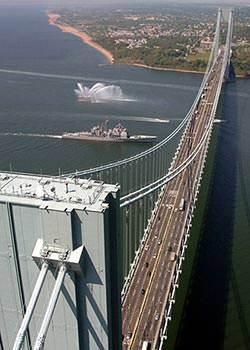
#9 THE BRIDGE WAS ABOUT TO BE NAMED AFTER JOHN F. KENNEDY
There was controversy regarding the naming of the bridge with authorities considering it too long and not knowing who Verrazzano was. It was finally accepted with efforts by the Italian Historical Society of America. However, after the assassination of John F. Kennedy in 1963, thousands of people demanded that the bridge be named after the President but Robert Kennedy made sure that it was named after the explorer.
#10 HE REMAINS POPULAR IN STATEN ISLAND
Verrazzano’s explorations increased the knowledge base of mapmakers regarding the geography of the East Coast of North America. He remains extremely popular in Staten Island, New York. A league is named after him and apart from the Verrazano–Narrows Bridge; two more bridges carry forward his name: Jamestown Verrazzano Bridge and Maryland’s Verrazano Bridge.
Giovanni da Verrazzano
Giovanni da Verrazzano, native of the castle in Greve, was born in 1485 to the Florentine noble parents Pier Andrea Bernardo da Verrazzano and Fiammetta Capelli. Between 1507 and 1508 he settled in Dieppe, France, where he came into contact with the leaders of the French Navy. Between 1522 and 1523 he persuaded King Francis I to promote an expedition aimed to find a passage to the west from the Atlantic to the Pacific Ocean. Verrazzano was thus the first to explore the east coast of the current United States of America. April 17, 1524 he reached the New York Bay. In 1528, during his third expedition, Verrazzano was captured and eaten by a tribe of cannibals. With Columbus, Vespucci and Cabot, Verrazzano is one of the great Italians who contributed to the exploration of the New World.
The personageThe travel diary
Florence in the XVI Century
The Renaissance was a period of great economic and cultural prosperity in Europe. The epicenter of this renewal was Florence, where intellectuals developed a new conception of mankind, pointing out his natural and earthly values in line with the objectives of the Medicean Oligarchy. The pressure of the Florentine big bankers and patrons business and building bloomed, infusing new stimuli to the literary, historical and artistic world at the same time. The classical culture was rediscovered and enhanced through a new philological approach. The colonial expansion broadened the horizon of the European world by moving the fulcrum of trade from the Mediterranean Sea to the Atlantic Ocean. The Florentine Renaissance knew a first crisis after the death of Lorenzo The Magnificent (1492) which was followed by the restoration of a medieval theocratic Republic established by G. Savonarola, intended to last beyond his burning at the stake in 1498.
Technical innovations and great voyages
Between the XV and the XVI Century, the ocean crossings were made possible by the technological development of shipbuilding. The ship “Delfina”, with which Verrazzano reached the American east coast, was a carrack, or a sailing vessel with three or four trees adopted in the Mediterranean Sea in the XV Century and designed in its essential traits by the Genoeses who, unlike the Venetians, had always preferred to use large ocean-going vessels for their trade. Large enough to face the rough seas and roomy enough to carry provisions, it was the first vessel designed for the oceanic navigation in Europe.
The Discovery
Livorno, Impruneta, Monte Morello, Careggi, Orto dei Rucellai, S. Gallo, Vallombrosa, Annunziata are just some of the Tuscan place names that Verrazzano gave to some of the areas he explored. Unfortunately, many of them disappeared soon overshadowed by the dominant Spanish and Portuguese cartography.
Here are the names that the Florentine navigator attributed to the coastal terriotories, according to a well-established reconstruction:
- Wood of the Laurels (South Carolina)
- Annunziata (North Carolina)
- Arcade (Washington DC)
- Vendome (Delaware)
- Bay of St. Marguerite Angouleme (New York)
- Refuge (Connecticut)
- Land of Evil People (Massachusetts)
- Land of the Bretons (Nova Scotia)
American Indians
“They are dark-skinned, similar to the Ethiopians. They have black, thick and not very long hair […] Well proportioned, of medium height, sometimes higher than ours, with a broad chest, strong arms and nicely laid out legs and other body parts. Their eyes are large and black, watchful and lively. They do not have a great physical strength but a keen intelligence and are agile and very strong runners […] They are very generous. They are willing to give everything they have. We struck up a good friendship with them.”
(G. da Verrazzano, letter to the King of France Francis I, July 1524)
The NY Bridge
The Verrazano Narrows Bridge in New York is one of the greatest awards dedicated to the Florentine navigator. Designed by O. H. Amman, already famous for the Golden Gate in San Francisco, it was inaugurated November 21, 1964 and bears the name of Verrazano (one zeta) according to the XV Century spelling. On April 17, 1963 three stones extracted from the foundations of Castello di Verrazzano were walled up at the entrance to the viaduct of the bridge. On the same day, three stones from the foundation of the bridge were affixed to the front of the villa in Greve.
The Gastronomic Revolution
The discovery of the New World represented a revolution in the diet of the Old Continent, contributing to the introduction of several products now become real pillars of the European cuisine. Initially traded for their mostly ornamental function (such as tomato), or intended for animal feed (such as corn), they have then radically changed our eating habits. Among the most important ones we can also mention cocoa, potatoes, beans, peppers, pumpkins, vanilla, pineapples and turkey meat.
From Wikipedia, the free encyclopedia
|
Giovanni da Verrazzano |
|
|---|---|
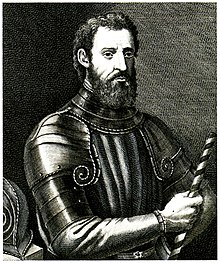 |
|
| Born | 1485
Val di Greve, Republic of Florence (now Italy) |
| Died | 1528 (aged 42–43)
Guadeloupe |
| Nationality | Italian |
| Other names | Janus Verrazanus, Jehan de Verrazane |
| Occupation | Explorer |
| Signature | |
Giovanni da Verrazzano ( VERR-ə-ZAH-noh, -ət-SAH—,[1][2][3][4] Italian: [dʒoˈvanni da (v)verratˈtsaːno], often misspelled Verrazano in English;[5] 1485–1528) was an Italian[6] (Florentine) explorer[7][8] of North America, in the service of King Francis I of France.
He is renowned as the first European to explore the Atlantic coast of North America between Florida and New Brunswick in 1524, including New York Bay and Narragansett Bay.[9]
Early life[edit]
Verrazzano was born in Val di Greve, south of Florence, the capital and the main city of the Republic of Florence,[10][11][12][13][14] the son of Piero Andrea di Bernardo da Verrazzano and Fiammetta Cappelli. It is generally claimed that he was born in the Castello di Verrazzano, hence its birth indicator (similar to Leonardo da Vinci).
Some alternative theories have been elaborated; for example, certain French scholarship assumes that Verrazzano was born in Lyon, France, the son of Alessandro di Bartolommeo da Verrazano and Giovanna Guadagni.[15][16]
«Whatever the case,» writes Ronald S. Love, «Verrazzano always considered himself to be Florentine,»[17] and he was considered a Florentine by his contemporaries as well.[18]
He signed documents employing a Latin version of his name, «Janus Verrazanus», and he called himself «Jehan de Verrazane» in his will dated 11 May 1526 in Rouen, France (preserved at the Archives départementales de la Seine-Maritime).[19]
In contrast to his detailed account of his voyages to North America, little is known about his personal life. After 1506, he settled in the port of Dieppe, Kingdom of France, where he began his career as a navigator.[20]
He embarked for the American coast probably in 1508 in the company of captain Thomas Aubert, on the ship La Pensée, equipped by the owner, Jean Ango.[20] He explored the region of Newfoundland, possibly during a fishing trip, and possibly the St. Lawrence River in Canada; on other occasions, he made numerous voyages to the eastern Mediterranean.[21][22]
1522–24 voyage to America[edit]
In September 1522, the surviving members of Ferdinand Magellan’s crew returned to Spain, having circumnavigated the globe. Competition in trade was becoming urgent, especially with Portugal.
King Francis I of France was impelled by French merchants and financiers from Lyon and Rouen who were seeking new trade routes and so he asked Verrazzano in 1523 to make plans to explore on France’s behalf an area between Florida and Terranova, the «New Found Land», with the goal of finding a sea route to the Pacific Ocean.
Within months, four ships set sail due west for the Grand Banks of Newfoundland, but a violent storm and rough seas caused the loss of two ships. The remaining two damaged ships, La Dauphine and La Normande, were forced to return to Brittany.[23]
Repairs were completed in the final weeks of 1523, and the ships set sail again. This time the ships headed south toward calmer waters, which were under hostile Spanish and Portuguese control.
After a stop in Madeira, complications forced La Normande back to home port, but Verrazzano’s ship La Dauphine departed on January 17, 1524, piloted by Antoine de Conflans, and headed once more for the North American continent.[24]
It neared the area of Cape Fear on about March 21st and, after a short stay, reached the Pamlico Sound lagoon of modern North Carolina. In a letter to Francis I described by historians as the Cèllere Codex, Verrazzano wrote that he was convinced that the Sound was the beginning of the Pacific Ocean from which access could be gained to China.[25][26]
Verrazzano’s voyage in 1524
Continuing to explore the coast further northwards, Verrazzano and his crew came into contact with Native Americans living on the coast. However, he did not notice the entrances to Chesapeake Bay or the mouth of the Delaware River.[27]
In New York Bay, he encountered the Lenape in about 30 Lenape canoes and observed what he deemed to be a large lake, really the entrance to the Hudson River. He then sailed along Long Island and entered Narragansett Bay, where he received a delegation of Wampanoag and Narragansett people.
The words «Norman villa» are found on the 1527 map by Visconte Maggiolo identifying the site. The historian Samuel Eliot Morison writes that «this occurs at Angouleme (New York) rather than Refugio (Newport). It was probably intended to compliment one of Verrazzano’s noble friends. There are several places called ‘Normanville’ in Normandy, France. The main one is located near Fécamp and another important one near Évreux, which would naturally be it. West of it, conjecturally on the Delaware or New Jersey coast, is a Longa Villa, which Verrazzano certainly named after François d’Orléans, duc de Longueville.»[27] He stayed there for two weeks and then moved northwards.[28]
He discovered Cape Cod Bay, his claim being proved by a map of 1529 that clearly outlined Cape Cod.[28] He named the cape after a general, calling it Pallavicino.[29] He then followed the coast up to modern Maine, southeastern Nova Scotia, and Newfoundland, and he then returned to France by 8 July 1524. Verrazzano named the region that he explored Francesca in honor of the French king, but his brother’s map labeled it Nova Gallia (New France).[30]
Later life and death[edit]
Verrazzano arranged a second voyage, with financial support from Jean Ango and Philippe de Chabot, which departed from Dieppe with four ships early in 1527. One ship was separated from the others in a gale near the Cape Verde Islands, but Verrazzano reached the coast of Brazil with two ships and harvested a cargo of brazilwood before returning to Dieppe in September. The third ship returned later, also with a cargo of brazilwood.[31]
The partial success did not find the desired passage to the Pacific Ocean, but it inspired Verrazzano’s final voyage, which left Dieppe in early 1528.[32]
There are conflicting accounts of Verrazzano’s demise. In one version, during his third voyage to North America in 1528, after he had explored Florida, the Bahamas, and the Lesser Antilles, Verrazzano anchored out to sea and rowed ashore, probably on the island of Guadeloupe. He was allegedly killed and eaten by the native Caribs.[33] The fleet of two or three ships was anchored out of gunshot range, and no one could respond in time.[34] However, older historical accounts suggest that Verrazzano was the same person as the corsair Jean Fleury, who was executed for piracy by the Spanish at Puerto del Pico, Spain.[35][36]
Legacy[edit]
1527 map by Visconte Maggiolo showing the east coast of North America with «Tera Florida» at top right and «Lavoradore» (Labrador) at bottom left. The information supposedly[37] came from Giovanni da Verrazzano’s voyage in 1524. (Biblioteca Ambrosiana Milan.)
The geographic information derived from this voyage had a significant influence on sixteenth-century cartographers.[38] Despite his discoveries, Verrazzano’s reputation did not proliferate as much as other explorers of that era. For example, Verrazzano gave the European name Francesca to the new land that he had seen, in accordance with contemporary practices, after the French king in whose name he sailed. That and other names that he bestowed on features that he discovered have not survived. He had the misfortune of making major discoveries in the same three years (1519 to 1521) that the dramatic Conquest of the Aztec Empire and Ferdinand Magellan’s circumnavigation of the world occurred. Magellan himself did not complete his voyage, but his publicist Antonio Pigafetta did so, and Spanish publicity outweighed the news of the French voyage.
In the 19th and the early 20th centuries, there was a great debate in the United States about the authenticity of the letters that he wrote to Francis I to describe the geography, flora, fauna, and native population of the east coast of North America.[39] Others thought that they were authentic, almost universally the current opinion,[40] particularly after the discovery of a letter signed by Francis I, which referred to Verrazzano’s letter.[41]
Verrazzano’s reputation was particularly obscure in New York City, where the 1609 voyage of Henry Hudson on behalf of the Dutch Republic came to be regarded as the de facto start of European exploration of New York. It was only by a great effort in the 1950s and 1960s that Verrazzano’s name and reputation were re-established as the European discoverer of the harbor, during an effort to name the newly built Narrows bridge after him.[42]
Commemorations[edit]
- In 1909, during the Hudson-Fulton Celebration, a bronze statue of Verrazzano by Ettore Ximenes was installed in Battery Park in Manhattan.[43]
- There are numerous commemorations of the explorer on Staten Island.
- The Verrazzano-Narrows Bridge, spanning The Narrows that separate Staten Island from Brooklyn, is perhaps the best known. Until October 2018, it was known as the «Verrazano-Narrows Bridge» with one «z».[44][45]
- A Staten Island Ferry boat that served New York from the 1950s to the 1990s was also named for Verrazzano. The ferry was named the «Verrazzano», while the bridge was named «Verrazano», reflecting the confusion over the spelling of his name.[46]
- A Little League team on Staten Island is also named for him.[47]
- The Jamestown Verrazzano Bridge in Narragansett Bay, Rhode Island, is named for him, as is Maryland’s Verrazano Bridge.[48]
- A vessel of the Regia Marina, a destroyer of the Navigatori class, was named after Verrazzano. She was launched in 1930 and sunk by a British submarine in 1942.
- There is a statue of him in the town of Greve in Chianti, Italy.[49]
- There is a monument commemorating him in Rehoboth Beach, Delaware; it states on its south face:
In Commemoration of
Verrazzano’s
Voyage to
America
erected by the
Delaware Commission on
Italian Heritage and Culture
2008[50]
- The monument further states on its east face:
A native of Val Di Greve in the Tuscany region of Italy, he studied navigation as a young man and became a master mariner. He was engaged by the King of France to lead a voyage to North America in 1524. The purpose of Verrazzano’s journey was to learn more about the continent. Traveling in a small ship known as the Dauphine, he explored coastal areas from the present-day State of North Carolina to Canada, observing the natural abundance of the land and the vibrant culture of its native peoples. His voyage is the earliest documented European exploration of this part of the Atlantic Coast.
This monument rests upon stone from Castello di Verrazzano, the explorer’s ancestral home.[50]
References[edit]
- ^ «Verrazano». The American Heritage Dictionary of the English Language (5th ed.). HarperCollins. Retrieved 28 August 2019.
- ^ «Verrazano». Collins English Dictionary. HarperCollins. Retrieved 28 August 2019.
- ^ «Verrazano, Giovanni da». Lexico US English Dictionary. Oxford University Press.[dead link]
- ^ «Verrazano». Merriam-Webster Dictionary. Retrieved 28 August 2019.
- ^ Fitzsimmons, Emma G. (14 June 2016), «Some See the Verrazano Bridge. Others See a Big Typo.», The New York Times
- ^ «Giovanni da Verrazzano». Encyclopedia Britannica. Retrieved 29 December 2022.
- ^ «Giovanni da Verrazzano | Italian navigator». Britannica.com. 29 January 2016. Retrieved 22 February 2017.
- ^ di Sergio Parmentola. «Verrazzano, Giovanni da in «Enciclopedia dei ragazzi»«. Treccani.it. Retrieved 22 February 2017.
- ^ Greene, George Washington (1837). The Life and Voyages of Verrazzano. Cambridge University: Folsom, Wells, and Thurston. p. 13. Retrieved 18 August 2017 – via Internet Archive.
He made several excursions up Narragansett Bay, and examined it with considerable attention.
- ^ Morison, Samuel Eliot (1971). The European Discovery of America: The Northern Voyages. New York: Oxford University Press. p. 283. ISBN 0-19-215941-0.
- ^ Giovanni Da Verrazzano, «Life» – Centro Studi Da Verrazzano. Archived 2012-01-15 at the Wayback Machine
- ^ Henry C. Murphy, The Voyage of The Verrazzano, Kessinger Publishing, 2004, p. 90. – Google Books
- ^ Dale Anderson et al., Explorers and Exploration, Marshall Cavendish Corporation, 2005, p. 765: «Giovanni da Verrazzano was born into a wealthy family in the Castle of Verrazzano, on a hilltop overlooking the Greve valley, a wine-producing area thirty miles south of Florence, in central Italy.» – Google Books
- ^ «Verrazano, Giovanni da» entry in David Buisseret, The Oxford Companion to World Exploration, vol. 2, Oxford University Press, 2007, p. 332: «Thirty miles south of Florence, in the Tuscan town of Greve, explorer Giovanni da Verrazano (sometimes spelled Verrazzano) was born.» – Google Books
- ^ Habert, Jacques (1964). La vie et les voyages de Jean de Verrazane. Montréal & Ottawa: Cercle du livre de France. p. 182.
- ^ Boucher, Alain (2006). Jean de Verrazane : un lyonnais découvre le site de New-York. Lyon: University Claude Bernard Lyon-1.
- ^ Ronald S. Love, [Maritime exploration in the age of discovery, 1415–1800, Greenwood Publishing Group, 2006, p. 133: «Giovanni da Verrazano was probably born to an aristocratic family from Greve in Tuscany, Italy, though he might also have been born to Italian parents living in Lyon, France. Whatever the case, Verrazano always considered himself to be Florentine». – Google Books
- ^ Richard Di Giacomo, The New Man and the New World: The Influence of Renaissance Humanism on the Explorers of the Italian Era of Discovery [Perfect Paperback], Magnifico Publications, 2002: «he was considered a Florentine by his contemporaries, and his association with the Florentine colony of merchants and bankers living in Lyons proved to be of great benefit to his career as an explorer.» – Google Books
- ^ Ballesteros-Gaibrois, Manuel (1968). La Découverte de l’Amérique. Paris: Librairie Philosophique J. Vrin. p. 51. ISBN 978-2-7116-0172-1.
- ^ a b Morison, Samuel Eliot (1971). The European Discovery of America: The Northern Voyages. New York: Oxford University Press. pp. 260–261.
- ^ «Carolana Explorers — Giovanni Da Verrazzano». www.carolana.com. Retrieved 15 August 2020.
- ^ «French Explorers | History of Western Civilization II». courses.lumenlearning.com. Retrieved 15 August 2020.
- ^ Marcel Trudel, The Beginnings of New France 1524-1663 (Toronto: McClelland & Stewart, 1973), p. 4.
- ^ Shaw, Edward Richard (1900). Discoverers and Explorers. American Book Company. p. 103. ISBN 1-4353-8990-5.
Verrazzano january 17.
- ^ «Verrazano Expedition». www.ncpedia.org. Retrieved 15 August 2020.
- ^ Knecht, R. J. (1984). Francis I. Cambridge: Cambridge University Press. p. 331. ISBN 978-0-52127-887-4.
- ^ a b Morison, Samuel Eliot (1971). The European Discovery of America: The Northern Voyages. New York: Oxford University Press. p. 490. ISBN 0-19-215941-0.
- ^ a b History of Barnstable County, Massachusetts. 1890. p. 950. Retrieved 27 February 2017.
- ^ D’Epiro, Peter; Pinkowish, Mary Desmond (2001). «Twenty-four: A new world beckons: Columbus, Cabot, Vespucci, Verrazano». Sprezzatura: 50 Ways Italian Genius Shaped the World. New York: Anchor Books. p. 180. ISBN 0-385-72019-X.
- ^ Morison, Samuel Eliot (1971). The European Discovery of America: The Northern Voyages. New York: Oxford University Press. p. 323. ISBN 0-19-215941-0.
- ^ Morison, Samuel Eliot (1971). The European Discovery of America: The Northern Voyages. New York: Oxford University Press. p. 314. ISBN 0-19-215941-0.
- ^ «Giovanni da Verrazzano, Italian navigator». Encyclopaedia Britannica. 1 January 2019. Retrieved 18 January 2019.
His final voyage began in the spring of 1528, when he sailed with his brother, Girolamo, from Dieppe with two or three ships.
- ^ Wroth, Lawrence C. (1970). The Voyages of Giovanni da Verrazzano, 1524–1528. New Haven: Yale University Press. p. 237. ISBN 0-300-01207-1.
- ^ Morison, Samuel Eliot (1971). The European Discovery of America: The Northern Voyages. New York: Oxford University Press. p. 315. ISBN 0-19-215941-0.
- ^ Murphy, Henry Cruse (1875). The Voyage of Verrazzano: A Chapter in the Early History of Maritime Discovery in America. New York: Press of J. Munsell. p. 149.
- ^ Chester, Alden (1925). Courts and lawyers of New York: a history, 1609–1925, Volume 3. New York: The American Historical Society Inc. p. 23.
- ^ «16th Century Pennsylvania Maps». www.mapsofpa.com.
- ^ Castelnovi Michele, Rotta verso la Cina: “les Indes en Kathaye” obiettivo della prima spedizione di Verrazzano, tra illusione e catacresi, in “Miscellanea di Storia delle Esplorazioni” XLII, Genova, Bozzi, 2017, pp. 45-78
- ^ Thrower, Norman (2003) «Verrazzano, Giovanni Da», in: Speake, Jennifer (ed.) Literature of Travel and Exploration: An Encyclopedia, Vol. 3, New York; London : Fitzroy Dearborn, ISBN 1-57958-247-8
- ^ Wroth, Lawrence (1970) The Voyages of Giovanni da Verrazzano, 1524–2003′, New Haven : Pierpont Morgan Library by Yale University Press, ISBN 0-300-01207-1
- ^ Thrower, Norman (1979). «New Light on the 1524 Voyage of Verrazzano». Terrae Incognitae. 11 (11): 59–65. doi:10.1179/tin.1979.11.1.59.
- ^ Adler, Jerry. «The History of the Verrazano-Narrows Bridge, 50 Years After Its Construction». Smithsonian Magazine. Retrieved 15 August 2020.
- ^ «The Battery – Giovanni da Verrazzano». New York City Department of Parks & Recreation.
- ^ Campanile, Carl. «Cuomo Finally Fixes a 50-Year-Old Typo». Retrieved 1 October 2018.
- ^ Rivoli, Dan (1 October 2018). «Verrazzano Bridge finally gets name corrected, decades later». New York Daily News. Retrieved 2 October 2018.
- ^ Wang, Vivian (7 June 2018). «How Do You Solve a Problem Like the Verrazano? With an Extra Z». The New York Times. ISSN 0362-4331. Retrieved 15 August 2020.
- ^ «Verrazano Babe Ruth League». New York Sports Connection. Retrieved 15 August 2020.
- ^ «Jamestown Bridge aces spelling bee». www.jamestownpress.com. 7 July 2016. Retrieved 15 August 2020.
- ^ «Greve in Chianti». www.caftours.com. Retrieved 15 August 2020.
- ^ a b «Giovanni Da Verrazzano Historical Marker». Hmdb.org. Retrieved 22 February 2017.
Further reading[edit]
- Codignola, Luca (1999). «Another Look at Verrazzano’s Voyage, 1524». Acadiensis. 29 (1): 29–42. ISSN 0044-5851. JSTOR 30303228.
- Masini, Giancarlo; Gori, Iacopo (1999). How Florence Invented America, New York, Marsilio Publishers.
- Castelnovi Michele (2005), Luoghi e tempi di un errore cartografico: l’istmo di Verrazzano (1524-1593), in Luoghi e tempo nella cartografia, Atti del Convegno nazionale dell’Associazione Italiana di Cartografia Trieste aprile 2005, a cura di C. Donato, in “Bollettino dell’Associazione Italiana di Cartografia”, nn. 123-124, Trieste, 2005, pp. 295-306.
External links[edit]
- Verrazzano Centre for Historical Studies
Презентация на тему: » History of New York City New York City was discovered in 1524 by Giovanni da Verrazzano, an Italian explorer. Europeans started to settle there once a.» — Транскрипт:
1
2
History of New York City New York City was discovered in 1524 by Giovanni da Verrazzano, an Italian explorer. Europeans started to settle there once a Dutch fur trading settlement was founded, and they gave it the name «New Amsterdam. Some time after, the island of Manhattan was purchased by Peter Minuit for what would be $1000 today. After it was purchased by him, the English conquered it in 1664 and finally gave it its name as of today, New York. It became the largest U.S. city by 1790.
3
History of New York City
4
Facts about New York City It is the largest city in the United States, with a population of over 8 million people Contrary to popular belief, Brooklyn is actually the most populated district of New York City, and Queens is the second, Manhattan is third As of 2005, over 170 languages were spoken in the city, and 36% of its population was born outside of the U.S.
5
Facts about New York City New York City is home to over 1700 parks, and the biggest is actually Pelham Bay Park located in the Bronx, not Central Park in Manhattan NYC has had the lowest crime rate of the 25 largest U.S. cities since 2005
6
Things to do in New York City Take a ferry to the Statue of Liberty/Ellis Island Visit the Empire State Building Go see the World Trade Center Memorial Buy buss passes and see all the different Manhattan neighborhoods by double decker bus See a Broadway play
7
Things to do in New York City Walk through Times Square Take a night time cruise on the Hudson River to see a great view of the skyline Shop on 5 th Avenue Visit Central park
Giovanni da Verrazzano Biography
(Explorer)
Born: 1485
Born In: Greve in Chianti
Giovanni da Verrazzano was an Italian explorer who became the first European to sight New York and Narragansett Bay while exploring the Atlantic coast of North America between Florida and New Brunswick. He is also credited with discovering the Virginia and Delaware Capes, New Jersey, Rhode Island, Massachusetts Bay, and the Maine Coast. Born in Florence, Italy, he embarked on a maritime career as a young man. Curious and brave, he ventured off to visit places like Egypt and Syria which were not only difficult to reach, but also considered mysterious and dangerous places for explorers. His adventurous spirit then took him to France where he entered the service of King Francis I who sent him to explore the East Coast of North America for a route to the Pacific. On his first exploration under French auspices he discovered New York Harbor while exploring the area near what would be North Carolina. Even though he could not find a passage to the Pacific Ocean and Asia—which was the primary purpose he sought—his first exploration of the Americas added vastly to the existing maritime knowledge. He left on another voyage, seeking a passage to India, in 1528 when his fleet drifted off into the Caribbean Sea. While sailing south of Jamaica, he left his ship to explore an unknown island where he was captured, killed and eaten by cannibals
(1485-1528)
Who Was Giovanni da Verrazzano?
Around 1506 or 1507, Giovanni da Verrazzano began pursuing a maritime career, and in the 1520s, he was sent by King Francis I of France to explore the East Coast of North America for a route to the Pacific. He made landfall near what would be Cape Fear, North Carolina, in early March and headed north to explore. Verrazzano eventually discovered New York Harbor, which now has a bridge spanning it named for the explorer. After returning to Europe, Verrazzano made two more voyages to the Americas. On the second, in 1528, he was killed and eaten by the natives of one of the Lower Antilles, probably on Guadeloupe.
Early Years
Giovanni da Verrazzano was born around 1485 near Val di Greve, Italy. Verrazzano was introduced to adventure and exploration at an early age. He first headed to Egypt and Syria, places that were considered mysterious and nearly impossible to reach at the time. Sometime between 1507 and 1508, Verrazzano went to France, where he met with King Francis I. He also came in contact with members of the French navy, and began to get a feel for the navy’s missions and building rapport with the sailors and commanders.
During this period, Christopher Columbus, Amerigo Vespucci and Ferdinand Magellan were making names for themselves with their explorations on behalf of Spain and Portugal, and Francis I grew concerned as France fell behind in the exploration of the West. Reports were coming back of riches in the New World, and paired with the idea of expanding his empire overseas, Francis I began planning an expedition on behalf of his country.
Voyages and Route
Verrazzano and Francis I met between 1522 and 1523, and Verrazzano convinced the king that he would be the right man to undertake exploratory voyages to the West on behalf of France; Francis I signed on. Verrazzano prepared four ships, loaded with ammunition, cannons, lifeboats, and scientific equipment, with provisions to last eight months. The flagship was named Delfina, in honor of the King’s firstborn daughter, and it set sail with the Normanda, Santa Maria and Vittoria. The Santa Maria and Vittoria were lost in a storm at sea, while the Delfina and the Normanda found their way into battle with Spanish ships. In the end, only the Delfina was seaworthy, and it headed to the New World during the night of January 17, 1524. Like many explorers of the day, Verrazzano was ultimately seeking a passage to the Pacific Ocean and Asia, and he thought that by sailing along the northern coastline of the New World he would find a passageway to the West Coast of North America.
After 50 days at sea, the men aboard the Delfina sighted land — generally thought to be near what would become Cape Fear, North Carolina. Verrazzano first steered his ship south, but upon reaching the northern tip of Florida, he turned and headed north, never losing sight of the coastline. On April 17, 1524, the Delfina entered the Bay of New York. He landed on the southern tip of Manhattan, where he stayed until a storm a pushed him toward Martha’s Vineyard. He finally came to rest at what is known today as Newport, Rhode Island. Verrazzano and his men interacted with the local population there for two weeks, before returning to France in July 1524.
Accomplishments
Verrazzano added greatly to the knowledge base of mapmakers in terms of the geography of the East Coast of North America. In honor of the famed explorer, the bridge spanning the Narrows between Brooklyn and Staten Island now bears his name. The Jamestown Verrazzano Bridge in Rhode Island is also named in honor of the explorer.
Death
In March 1528, Verrazzano left France on his final voyage, yet again seeking the passage to India (after not having found it via a South American voyage the year before). The expedition, which included Verrazzano’s brother, Girolamo, sailed along the coast of Florida before drifting into the Caribbean Sea. This turned out to be the last mistake the explorer would ever make.
While sailing south of Jamaica, the crew spotted a heavily vegetated, seemingly unpopulated island, and Verrazzano dropped anchor to explore it with a handful of crewmen. The group was soon attacked by a large assemblage of cannibalistic natives who killed them and ate them all as Girolamo and the rest of the crew watched from the main ship, unable to help.
QUICK FACTS
- Birth Year: 1485
- Birth City: Val di Greve
- Birth Country: Italy
- Gender: Male
- Best Known For: Giovanni da Verrazzano was an Italian explorer who charted the Atlantic coast of North America between the Carolinas and Newfoundland, including New York Harbor in 1524. The Verrazano–Narrows Bridge in New York was named after him.
- Nacionalities
- Italian
- Death Year: 1528
- Death City: Lesser Antilles
Fact Check
We strive for accuracy and fairness.If you see something that doesn’t look right,contact us!
CITATION INFORMATION
- Article Title: Giovanni da Verrazzano Biography
- Author: Biography.com Editors
- Website Name: The Biography.com website
- Url: https://www.biography.com/history-culture/giovanni-da-verrazzano
- Access Date:
- Publisher: A&E; Television Networks
- Last Updated: August 20, 2020
- Original Published Date: April 2, 2014
Giovanni da Verrazzano ( VERR-ə-ZAH-noh, -ət-SAH—,[1][2][3][4] Italian: [dʒoˈvanni da (v)verratˈtsaːno], often misspelled Verrazano in English;[5] 1485–1528) was an Italian[6] (Florentine) explorer[7][8] of North America, in the service of King Francis I of France.
He is renowned as the first European to explore the Atlantic coast of North America between Florida and New Brunswick in 1524, including New York Bay and Narragansett Bay.[9]
Early life
Verrazzano was born in Val di Greve, south of Florence, the capital and the main city of the Republic of Florence,[10][11][12][13][14] the son of Piero Andrea di Bernardo da Verrazzano and Fiammetta Cappelli. It is generally claimed that he was born in the Castello di Verrazzano, hence its birth indicator (similar to Leonardo da Vinci).
Some alternative theories have been elaborated; for example, certain French scholarship assumes that Verrazzano was born in Lyon, France, the son of Alessandro di Bartolommeo da Verrazano and Giovanna Guadagni.[15][16]
«Whatever the case,» writes Ronald S. Love, «Verrazzano always considered himself to be Florentine,»[17] and he was considered a Florentine by his contemporaries as well.[18]
He signed documents employing a Latin version of his name, «Janus Verrazanus», and he called himself «Jehan de Verrazane» in his will dated 11 May 1526 in Rouen, France (preserved at the Archives départementales de la Seine-Maritime).[19]
In contrast to his detailed account of his voyages to North America, little is known about his personal life. After 1506, he settled in the port of Dieppe, Kingdom of France, where he began his career as a navigator.[20]
He embarked for the American coast probably in 1508 in the company of captain Thomas Aubert, on the ship La Pensée, equipped by the owner, Jean Ango.[20] He explored the region of Newfoundland, possibly during a fishing trip, and possibly the St. Lawrence River in Canada; on other occasions, he made numerous voyages to the eastern Mediterranean.[21][22]
1522–24 voyage to America
In September 1522, the surviving members of Ferdinand Magellan’s crew returned to Spain, having circumnavigated the globe. Competition in trade was becoming urgent, especially with Portugal.
King Francis I of France was impelled by French merchants and financiers from Lyon and Rouen who were seeking new trade routes and so he asked Verrazzano in 1523 to make plans to explore on France’s behalf an area between Florida and Terranova, the »New Found Land», with the goal of finding a sea route to the Pacific Ocean.
Within months, four ships set sail due west for the Grand Banks of Newfoundland, but a violent storm and rough seas caused the loss of two ships. The remaining two damaged ships, La Dauphine and La Normande, were forced to return to Brittany.[23]
Repairs were completed in the final weeks of 1523, and the ships set sail again. This time the ships headed south toward calmer waters, which were under hostile Spanish and Portuguese control.
After a stop in Madeira, complications forced La Normande back to home port, but Verrazzano’s ship La Dauphine departed on January 17, 1524, piloted by Antoine de Conflans, and headed once more for the North American continent.[24]
It neared the area of Cape Fear on about March 21st and, after a short stay, reached the Pamlico Sound lagoon of modern North Carolina. In a letter to Francis I described by historians as the Cèllere Codex, Verrazzano wrote that he was convinced that the Sound was the beginning of the Pacific Ocean from which access could be gained to China.[25][26]

Verrazzano’s voyage in 1524
Continuing to explore the coast further northwards, Verrazzano and his crew came into contact with Native Americans living on the coast. However, he did not notice the entrances to Chesapeake Bay or the mouth of the Delaware River.[27]
In New York Bay, he encountered the Lenape in about 30 Lenape canoes and observed what he deemed to be a large lake, really the entrance to the Hudson River. He then sailed along Long Island and entered Narragansett Bay, where he received a delegation of Wampanoag and Narragansett people.
The words «Norman villa» are found on the 1527 map by Visconte Maggiolo identifying the site. The historian Samuel Eliot Morison writes that «this occurs at Angouleme (New York) rather than Refugio (Newport). It was probably intended to compliment one of Verrazzano’s noble friends. There are several places called ‘Normanville’ in Normandy, France. The main one is located near Fécamp and another important one near Évreux, which would naturally be it. West of it, conjecturally on the Delaware or New Jersey coast, is a Longa Villa, which Verrazzano certainly named after François d’Orléans, duc de Longueville.»[27] He stayed there for two weeks and then moved northwards.[28]
He discovered Cape Cod Bay, his claim being proved by a map of 1529 that clearly outlined Cape Cod.[28] He named the cape after a general, calling it Pallavicino.[29] He then followed the coast up to modern Maine, southeastern Nova Scotia, and Newfoundland, and he then returned to France by 8 July 1524. Verrazzano named the region that he explored Francesca in honor of the French king, but his brother’s map labeled it Nova Gallia (New France).[30]
Later life and death
Verrazzano arranged a second voyage, with financial support from Jean Ango and Philippe de Chabot, which departed from Dieppe with four ships early in 1527. One ship was separated from the others in a gale near the Cape Verde Islands, but Verrazzano reached the coast of Brazil with two ships and harvested a cargo of brazilwood before returning to Dieppe in September. The third ship returned later, also with a cargo of brazilwood.[31]
The partial success did not find the desired passage to the Pacific Ocean, but it inspired Verrazzano’s final voyage, which left Dieppe in early 1528.[32]
There are conflicting accounts of Verrazzano’s demise. In one version, during his third voyage to North America in 1528, after he had explored Florida, the Bahamas, and the Lesser Antilles, Verrazzano anchored out to sea and rowed ashore, probably on the island of Guadeloupe. He was allegedly killed and eaten by the native Caribs.[33] The fleet of two or three ships was anchored out of gunshot range, and no one could respond in time.[34] However, older historical accounts suggest that Verrazzano was the same person as the corsair Jean Fleury, who was executed for piracy by the Spanish at Puerto del Pico, Spain.[35][36]
Legacy
![1527 map by Visconte Maggiolo showing the east coast of North America with "Tera Florida" at top right and "Lavoradore" (Labrador) at bottom left. The information supposedly[37] came from Giovanni da Verrazzano's voyage in 1524. (Biblioteca Ambrosiana Milan.)](https://wiki2.org/wikipedia/commons/thumb/2/2f/1527-TeraFlorida.jpg/im244-320px-1527-TeraFlorida.jpg)
1527 map by Visconte Maggiolo showing the east coast of North America with «Tera Florida» at top right and «Lavoradore» (Labrador) at bottom left. The information supposedly[37] came from Giovanni da Verrazzano’s voyage in 1524. (Biblioteca Ambrosiana Milan.)
The geographic information derived from this voyage had a significant influence on sixteenth-century cartographers.[38] Despite his discoveries, Verrazzano’s reputation did not proliferate as much as other explorers of that era. For example, Verrazzano gave the European name Francesca to the new land that he had seen, in accordance with contemporary practices, after the French king in whose name he sailed. That and other names that he bestowed on features that he discovered have not survived. He had the misfortune of making major discoveries in the same three years (1519 to 1521) that the dramatic Conquest of the Aztec Empire and Ferdinand Magellan’s circumnavigation of the world occurred. Magellan himself did not complete his voyage, but his publicist Antonio Pigafetta did so, and Spanish publicity outweighed the news of the French voyage.
In the 19th and the early 20th centuries, there was a great debate in the United States about the authenticity of the letters that he wrote to Francis I to describe the geography, flora, fauna, and native population of the east coast of North America.[39] Others thought that they were authentic, almost universally the current opinion,[40] particularly after the discovery of a letter signed by Francis I, which referred to Verrazzano’s letter.[41]
Verrazzano’s reputation was particularly obscure in New York City, where the 1609 voyage of Henry Hudson on behalf of the Dutch Republic came to be regarded as the de facto start of European exploration of New York. It was only by a great effort in the 1950s and 1960s that Verrazzano’s name and reputation were re-established as the European discoverer of the harbor, during an effort to name the newly built Narrows bridge after him.[42]
Commemorations


- In 1909, during the Hudson-Fulton Celebration, a bronze statue of Verrazzano by Ettore Ximenes was installed in Battery Park in Manhattan.[43]
- There are numerous commemorations of the explorer on Staten Island.
- The Verrazzano-Narrows Bridge, spanning The Narrows that separate Staten Island from Brooklyn, is perhaps the best known. Until October 2018, it was known as the «Verrazano-Narrows Bridge» with one «z».[44][45]
- A Staten Island Ferry boat that served New York from the 1950s to the 1990s was also named for Verrazzano. The ferry was named the «Verrazzano», while the bridge was named «Verrazano», reflecting the confusion over the spelling of his name.[46]
- A Little League team on Staten Island is also named for him.[47]
- The Jamestown Verrazzano Bridge in Narragansett Bay, Rhode Island, is named for him, as is Maryland’s Verrazano Bridge.[48]
- A vessel of the Regia Marina, a destroyer of the Navigatori class, was named after Verrazzano. She was launched in 1930 and sunk by a British submarine in 1942.
- There is a statue of him in the town of Greve in Chianti, Italy.[49]
- There is a monument commemorating him in Rehoboth Beach, Delaware; it states on its south face:
In Commemoration of
Verrazzano’s
Voyage to
America
erected by the
Delaware Commission on
Italian Heritage and Culture
2008[50]
- The monument further states on its east face:
A native of Val Di Greve in the Tuscany region of Italy, he studied navigation as a young man and became a master mariner. He was engaged by the King of France to lead a voyage to North America in 1524. The purpose of Verrazzano’s journey was to learn more about the continent. Traveling in a small ship known as the Dauphine, he explored coastal areas from the present-day State of North Carolina to Canada, observing the natural abundance of the land and the vibrant culture of its native peoples. His voyage is the earliest documented European exploration of this part of the Atlantic Coast.
This monument rests upon stone from Castello di Verrazzano, the explorer’s ancestral home.[50]
References
- ^ «Verrazano». The American Heritage Dictionary of the English Language (5th ed.). HarperCollins. Retrieved 28 August 2019.
- ^ «Verrazano». Collins English Dictionary. HarperCollins. Retrieved 28 August 2019.
- ^ «Verrazano, Giovanni da». Lexico US English Dictionary. Oxford University Press.[dead link]
- ^ «Verrazano». Merriam-Webster Dictionary. Retrieved 28 August 2019.
- ^ Fitzsimmons, Emma G. (14 June 2016), «Some See the Verrazano Bridge. Others See a Big Typo.», The New York Times
- ^ «Giovanni da Verrazzano». Encyclopedia Britannica. Retrieved 29 December 2022.
- ^ «Giovanni da Verrazzano | Italian navigator». Britannica.com. 29 January 2016. Retrieved 22 February 2017.
- ^ di Sergio Parmentola. «Verrazzano, Giovanni da in »Enciclopedia dei ragazzi»«. Treccani.it. Retrieved 22 February 2017.
- ^ Greene, George Washington (1837). The Life and Voyages of Verrazzano. Cambridge University: Folsom, Wells, and Thurston. p. 13. Retrieved 18 August 2017 – via Internet Archive.
He made several excursions up Narragansett Bay, and examined it with considerable attention.
- ^ Morison, Samuel Eliot (1971). The European Discovery of America: The Northern Voyages. New York: Oxford University Press. p. 283. ISBN 0-19-215941-0.
- ^ Giovanni Da Verrazzano, «Life» – Centro Studi Da Verrazzano. Archived 2012-01-15 at the Wayback Machine
- ^ Henry C. Murphy, The Voyage of The Verrazzano, Kessinger Publishing, 2004, p. 90. – Google Books
- ^ Dale Anderson et al., Explorers and Exploration, Marshall Cavendish Corporation, 2005, p. 765: «Giovanni da Verrazzano was born into a wealthy family in the Castle of Verrazzano, on a hilltop overlooking the Greve valley, a wine-producing area thirty miles south of Florence, in central Italy.» – Google Books
- ^ «Verrazano, Giovanni da» entry in David Buisseret, The Oxford Companion to World Exploration, vol. 2, Oxford University Press, 2007, p. 332: «Thirty miles south of Florence, in the Tuscan town of Greve, explorer Giovanni da Verrazano (sometimes spelled Verrazzano) was born.» – Google Books
- ^ Habert, Jacques (1964). La vie et les voyages de Jean de Verrazane. Montréal & Ottawa: Cercle du livre de France. p. 182.
- ^ Boucher, Alain (2006). Jean de Verrazane : un lyonnais découvre le site de New-York. Lyon: University Claude Bernard Lyon-1.
- ^ Ronald S. Love, [Maritime exploration in the age of discovery, 1415–1800, Greenwood Publishing Group, 2006, p. 133: «Giovanni da Verrazano was probably born to an aristocratic family from Greve in Tuscany, Italy, though he might also have been born to Italian parents living in Lyon, France. Whatever the case, Verrazano always considered himself to be Florentine». – Google Books
- ^ Richard Di Giacomo, The New Man and the New World: The Influence of Renaissance Humanism on the Explorers of the Italian Era of Discovery [Perfect Paperback], Magnifico Publications, 2002: «he was considered a Florentine by his contemporaries, and his association with the Florentine colony of merchants and bankers living in Lyons proved to be of great benefit to his career as an explorer.» – Google Books
- ^ Ballesteros-Gaibrois, Manuel (1968). La Découverte de l’Amérique. Paris: Librairie Philosophique J. Vrin. p. 51. ISBN 978-2-7116-0172-1.
- ^ a b Morison, Samuel Eliot (1971). The European Discovery of America: The Northern Voyages. New York: Oxford University Press. pp. 260–261.
- ^ «Carolana Explorers - Giovanni Da Verrazzano». www.carolana.com. Retrieved 15 August 2020.
- ^ «French Explorers | History of Western Civilization II». courses.lumenlearning.com. Retrieved 15 August 2020.
- ^ Marcel Trudel, The Beginnings of New France 1524-1663 (Toronto: McClelland & Stewart, 1973), p. 4.
- ^ Shaw, Edward Richard (1900). Discoverers and Explorers. American Book Company. p. 103. ISBN 1-4353-8990-5.
Verrazzano january 17.
- ^ «Verrazano Expedition». www.ncpedia.org. Retrieved 15 August 2020.
- ^ Knecht, R. J. (1984). Francis I. Cambridge: Cambridge University Press. p. 331. ISBN 978-0-52127-887-4.
- ^ a b Morison, Samuel Eliot (1971). The European Discovery of America: The Northern Voyages. New York: Oxford University Press. p. 490. ISBN 0-19-215941-0.
- ^ a b History of Barnstable County, Massachusetts. 1890. p. 950. Retrieved 27 February 2017.
- ^ D’Epiro, Peter; Pinkowish, Mary Desmond (2001). «Twenty-four: A new world beckons: Columbus, Cabot, Vespucci, Verrazano». Sprezzatura: 50 Ways Italian Genius Shaped the World. New York: Anchor Books. p. 180. ISBN 0-385-72019-X.
- ^ Morison, Samuel Eliot (1971). The European Discovery of America: The Northern Voyages. New York: Oxford University Press. p. 323. ISBN 0-19-215941-0.
- ^ Morison, Samuel Eliot (1971). The European Discovery of America: The Northern Voyages. New York: Oxford University Press. p. 314. ISBN 0-19-215941-0.
- ^ «Giovanni da Verrazzano, Italian navigator». Encyclopaedia Britannica. 1 January 2019. Retrieved 18 January 2019.
His final voyage began in the spring of 1528, when he sailed with his brother, Girolamo, from Dieppe with two or three ships.
- ^ Wroth, Lawrence C. (1970). The Voyages of Giovanni da Verrazzano, 1524–1528. New Haven: Yale University Press. p. 237. ISBN 0-300-01207-1.
- ^ Morison, Samuel Eliot (1971). The European Discovery of America: The Northern Voyages. New York: Oxford University Press. p. 315. ISBN 0-19-215941-0.
- ^ Murphy, Henry Cruse (1875). The Voyage of Verrazzano: A Chapter in the Early History of Maritime Discovery in America. New York: Press of J. Munsell. p. 149.
- ^ Chester, Alden (1925). Courts and lawyers of New York: a history, 1609–1925, Volume 3. New York: The American Historical Society Inc. p. 23.
- ^ «16th Century Pennsylvania Maps». www.mapsofpa.com.
- ^ Castelnovi Michele, Rotta verso la Cina: “les Indes en Kathaye” obiettivo della prima spedizione di Verrazzano, tra illusione e catacresi, in “Miscellanea di Storia delle Esplorazioni” XLII, Genova, Bozzi, 2017, pp. 45-78
- ^ Thrower, Norman (2003) «Verrazzano, Giovanni Da», in: Speake, Jennifer (ed.) Literature of Travel and Exploration: An Encyclopedia, Vol. 3, New York; London : Fitzroy Dearborn, ISBN 1-57958-247-8
- ^ Wroth, Lawrence (1970) The Voyages of Giovanni da Verrazzano, 1524–2003′, New Haven : Pierpont Morgan Library by Yale University Press, ISBN 0-300-01207-1
- ^ Thrower, Norman (1979). «New Light on the 1524 Voyage of Verrazzano». Terrae Incognitae. 11 (11): 59–65. doi:10.1179/tin.1979.11.1.59.
- ^ Adler, Jerry. «The History of the Verrazano-Narrows Bridge, 50 Years After Its Construction». Smithsonian Magazine. Retrieved 15 August 2020.
- ^ «The Battery – Giovanni da Verrazzano». New York City Department of Parks & Recreation.
- ^ Campanile, Carl. «Cuomo Finally Fixes a 50-Year-Old Typo». Retrieved 1 October 2018.
- ^ Rivoli, Dan (1 October 2018). «Verrazzano Bridge finally gets name corrected, decades later». New York Daily News. Retrieved 2 October 2018.
- ^ Wang, Vivian (7 June 2018). «How Do You Solve a Problem Like the Verrazano? With an Extra Z». The New York Times. ISSN 0362-4331. Retrieved 15 August 2020.
- ^ «Verrazano Babe Ruth League». New York Sports Connection. Retrieved 15 August 2020.
- ^ «Jamestown Bridge aces spelling bee». www.jamestownpress.com. 7 July 2016. Retrieved 15 August 2020.
- ^ «Greve in Chianti». www.caftours.com. Retrieved 15 August 2020.
- ^ a b «Giovanni Da Verrazzano Historical Marker». Hmdb.org. Retrieved 22 February 2017.
Further reading
- Codignola, Luca (1999). «Another Look at Verrazzano’s Voyage, 1524». Acadiensis. 29 (1): 29–42. ISSN 0044-5851. JSTOR 30303228.
- Masini, Giancarlo; Gori, Iacopo (1999). How Florence Invented America, New York, Marsilio Publishers.
- Castelnovi Michele (2005), Luoghi e tempi di un errore cartografico: l’istmo di Verrazzano (1524-1593), in Luoghi e tempo nella cartografia, Atti del Convegno nazionale dell’Associazione Italiana di Cartografia Trieste aprile 2005, a cura di C. Donato, in “Bollettino dell’Associazione Italiana di Cartografia”, nn. 123-124, Trieste, 2005, pp. 295-306.
External links
- Verrazzano Centre for Historical Studies
This page was last edited on 9 March 2023, at 17:47

